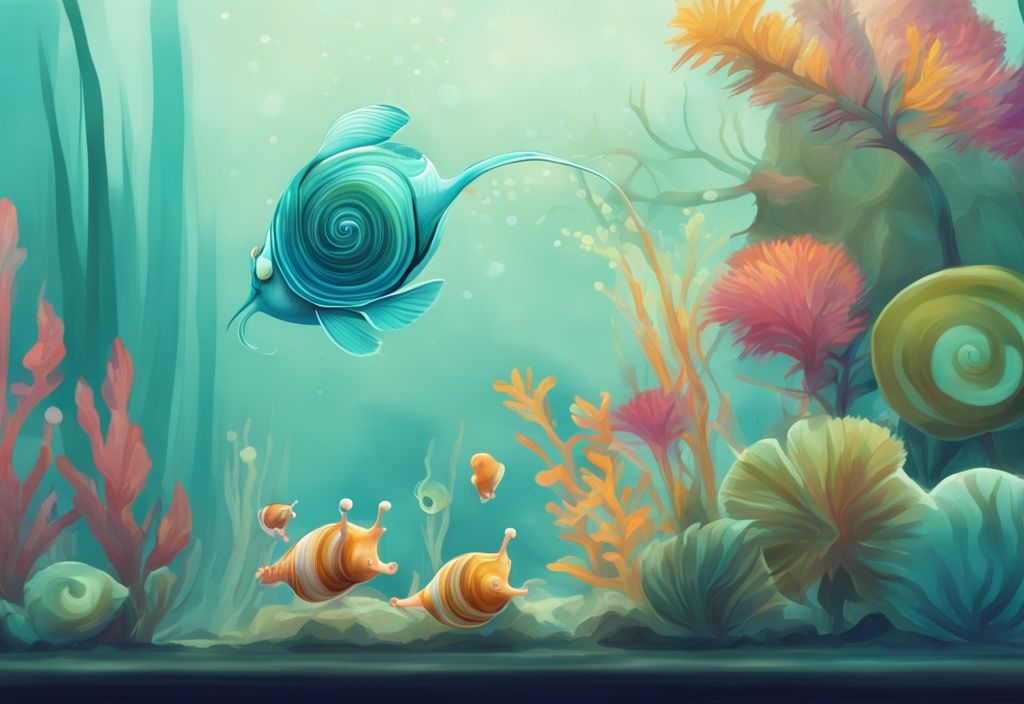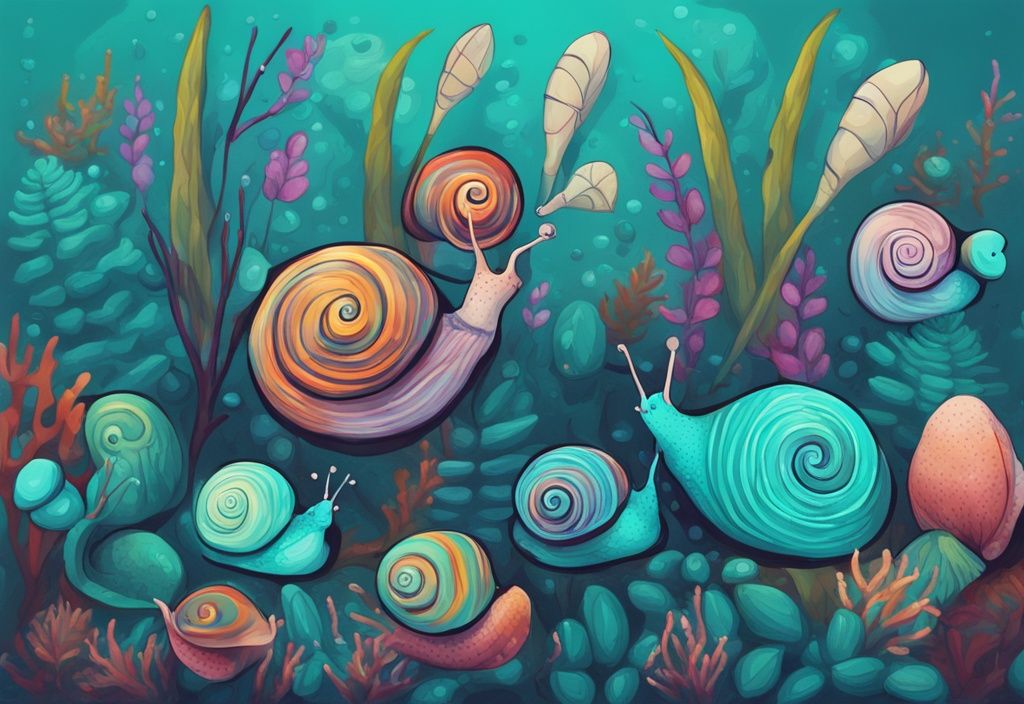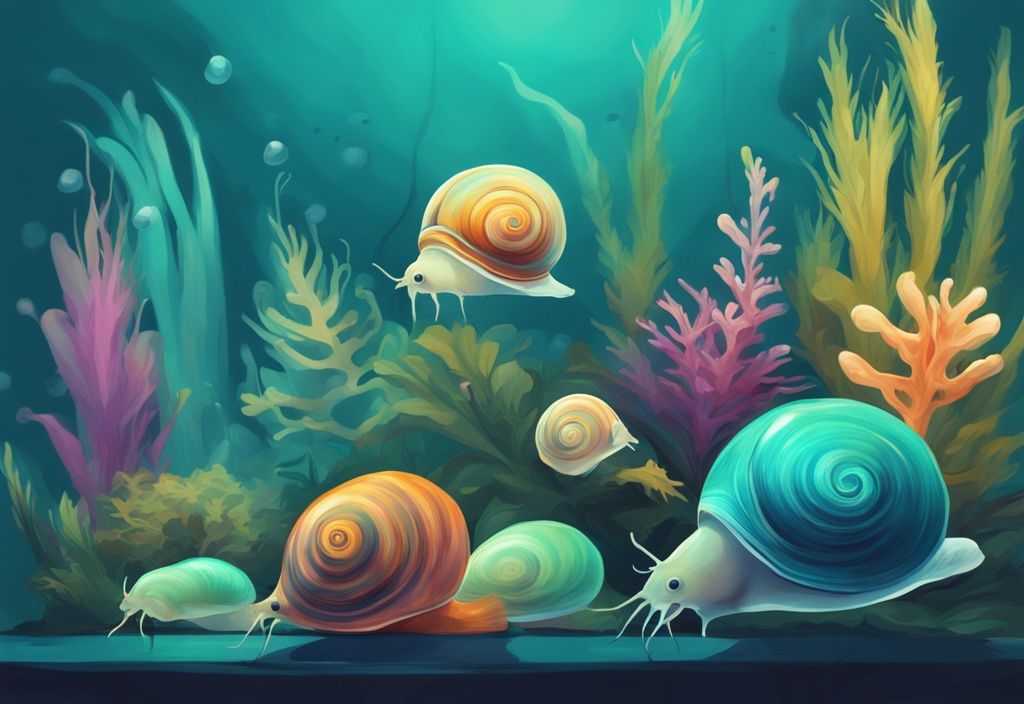Did you know aquarium snails, tiny as they may be, can make a massive impact on your tank’s ecosystem? With years of marine biology behind me, I can assure you, their role stretches far beyond simple aesthetics. This guide will take you through the ins and outs of every crevice.
You’ll unravel the snails’ unique contributions, from battling algae and managing leftover fish food to enhancing water quality. Curious about the best aquarium snails to choose and how to care for them? By the end of this article, you’ll have the knowledge you need at your fingertips.
So, if you’ve spotted a rogue snail sliding up your aquarium walls or merely wish to elevate your aquatic experience, delve right in. Brace for a transformation that’ll have your tank bursting with life and charm!
Why Snails are Beneficial to Your Aquarium
Enriching Your Aquatic Ecosystem: Functional Benefits
Aquarium snails play a pivotal role in maintaining a healthy tank environment, acting as natural janitors that graze on algae and dead plant matter, similar to the important roles freshwater snails play in the wild, as detailed in this insightful article on aquatic snails in Alabama. similar to the important roles freshwater snails play in the wild, as detailed in this insightful article on aquatic snails in Alabama. Acting as natural cleaners, they diligently consume leftover fish food, dead plant matter, and detritus, thus preventing the buildup of organic waste. This cleaning activity not only keeps the tank tidy but also aids in breaking down these organic materials into simpler nutrients, which are highly beneficial for the growth of aquatic plants. Certain species of aquarium snails excel at algae consumption, significantly reducing the need for chemical treatments and promoting a more balanced ecosystem.
Moreover, freshwater snails contribute to the health and vitality of aquatic plants by providing natural fertilizer through their waste, enriching the substrate with essential nutrients. Supporting this function, the burrowing activities of these snails help oxygenate the substrate, which, in turn, stabilizes water conditions beneficial for both plants and fish. This ongoing process ensures a well-aerated environment, fostering balanced water conditions and a thriving aquatic habitat.
Enhancing Your Tank’s Beauty: Aesthetic Benefits of Snails
Aquarium snails add a unique aesthetic dimension to any tank, enhancing its visual appeal. Available in a diverse array of sizes, shapes, and colors, these fascinating creatures bring an extra layer of intrigue and beauty to the aquatic landscape. Many species boast striking and unique shell patterns that can serve as natural works of art within your tank.
The slow, graceful movement of snails adds a serene and dynamic element to the aquarium’s visual dynamics. Their presence can transform the tank into a lively, engaging environment. For aquarists who favor naturalistic tank setups, snails can beautifully complement and enhance the overall aquascape.
Besides their aesthetic qualities, they are also low-maintenance pets, making them an ideal choice for aquarium enthusiasts looking for both functionality and beauty in their aquatic ecosystems. Their ease of care ensures that even novice aquarists can enjoy their benefits without additional effort.
The Ideal Aquarium Snail: Choosing What’s Best for Your Tank
Good Snails vs. Bad Snails: The Severely Underrated Heroes and the Villains
When considering aquarium snails, it’s crucial to distinguish between those that enhance your tank environment and those that might cause issues.
- Good Snails: Mystery Snails, Nerite Snails, Rabbit Snails, and Assassin Snails are celebrated for their beneficial characteristics. Mystery Snails add a pop of color while diligently cleaning algae, making them a visually appealing addition. Nerite Snails are also excellent algae eaters and can’t reproduce in freshwater, preventing population surges. Rabbit Snails, with their unique look and slower breeding rate, are ideal for aquascapes. Assassin Snails help control nuisance snail populations without harming your other tank inhabitants.
- Problematic Snails: Malaysian Trumpet Snails (MTS) aerate the substrate but can become overwhelming due to their rapid breeding. Ramshorn Snails, although effective cleaners, multiply quickly if food is plentiful. Pond Snails and Bladder Snails often become pests in nutrient-rich conditions, reproducing rapidly and taking over the tank. Active management is essential to maintain a balanced snail population.
Mystery, Nerite, Rabbit Snails and More: Popular Choices for Aquarists
Aquarium snails like Mystery Snails, Nerite Snails, Rabbit Snails, and Assassin Snails are favored by aquarists for their unique benefits and ease of care.
Mystery Snails offer vibrant colors and efficient algae eating. Note, though, that a secure lid is necessary as they are escape artists. They are gonochoristic, meaning you’ll need both a male and a female if you plan to breed them.
Nerite Snails are highly valued for their exceptional algae-eating ability and the fact that they cannot overpopulate your freshwater aquarium, since their larvae require brackish or saltwater to develop. This trait makes them an excellent choice for algae management without the risk of overbreeding.
Rabbit Snails are larger with an appealing appearance and breed slowly, making them a fantastic option for aquascapes. They thrive in slightly warmer, alkaline water conditions, bringing a unique presence to your tank.
Assassin Snails play a unique role by preying on other snails, thus controlling pest populations. They thrive in a burrowing substrate and, thanks to their slow breeding rate, are easy to manage.

Other snails like Ramshorn, Malaysian Trumpet Snails, and Pond and Bladder Snails have their benefits but also pose risks if not monitored. Ramshorn Snails, despite being effective cleaners, can multiply rapidly. Malaysian Trumpet Snails are excellent scavengers that help aerate the substrate but can become a challenge to eliminate if overpopulated. Pond and Bladder Snails may be beneficial but can turn into pests in nutrient-rich environments due to their quick reproduction.
Maintaining effective population control involves vigilant monitoring and reducing excess food and algae in the tank. By doing so, you can ensure a harmonious and balanced snail population within your aquarium.
Preparing Your Aquarium for New Snail Guests
Snails and Fish Compatibility: Ensuring a Peaceful Co-existence
When introducing aquarium snails to your tank, ensuring compatibility with existing fish is crucial. Freshwater snails generally cohabit well with a wide range of fish. However, it is vital to avoid aggressive tank mates such as crayfish, loaches, bettas, and gouramis, as these animals may prey on or harm the snails.
Before adding snails, observe the behavior of the existing fish to ensure they do not show predatory tendencies towards new snail inhabitants. The peaceful co-existence of fish and snails not only aids in maintaining a balanced ecosystem but also enhances the overall visual appeal of your aquarium, creating a serene environment. Picture it—a tranquil underwater haven where every creature thrives in harmony.
Water Quality Essentials for Snails
For the healthy upkeep of aquarium snails, maintaining optimal water quality is paramount. Snails thrive in water temperatures ranging from 65-82°F and a pH level between 7.0 and 8.0.
Regular water changes and efficient filtration are necessary to keep the environment clean and stable. Consistent monitoring of water parameters on a weekly basis ensures the conditions remain suitable for snail health. Additionally, it’s imperative to avoid copper-based medications, as these can be toxic to snails. By keeping water conditions favorable, you support the longevity and wellbeing of your snails, creating an ideal habitat for them to flourish.
Key Research Before Adding Snails to Your Aquarium
Before adding aquarium snails to your habitat, thorough research is necessary to address their specific needs. Each snail species may have unique dietary, breeding, and environmental requirements. It’s essential to evaluate the compatibility of snails with your current tank inhabitants to avoid potential conflicts.
Furthermore, investigate any regional legal restrictions regarding certain snail species to ensure compliance. Quarantining new snails before their introduction into the main tank is prudent as it helps in preventing the spread of parasites and diseases. This careful preparation guarantees the successful acclimatization of snails and promotes a harmonious tank environment.
Snail Nutrition: What to Feed Your Aquarium Snails
Aquarium snails are diligent cleaners, consuming algae, dead plant matter, and leftover fish food to keep tanks healthy. However, they need supplementary feeding to ensure they get all the necessary nutrients.
Natural Diet vs. Supplementary Feeding
Aquarium snails play a crucial role in maintaining a clean and balanced ecosystem. Their natural diet mainly consists of algae, dead plant matter, and leftover fish food. These dietary elements help keep the tank clean, as snails consume what might otherwise contribute to poor water quality.
In addition to their natural diet, it’s beneficial to provide supplementary feeding to ensure they receive all necessary nutrients. Blanched vegetables such as spinach, kale, and zucchini are excellent choices. These vegetables should be blanched to soften them, making it easier for snails to consume.
Specialized aquarium foods designed specifically for snails can also be a valuable addition to their diet, ensuring they get a balanced intake of vitamins and minerals. Additionally, incorporating sliced fruits into their diet can be healthy but should be given in moderation to avoid disrupting water quality.
Calcium: The Building Block of Snail Health
Calcium is essential for the proper shell development and maintenance of aquarium snails. An insufficient calcium level in their diet can lead to shell deformities and other health issues. Ensuring a steady supply of calcium is vital for keeping snails healthy.
There are several sources of calcium you can introduce into the aquarium. Crushed coral or cuttlebone added to the tank will gradually release calcium, benefiting the snails. Calcium-rich foods such as spinach, kale, and broccoli can be included in their diet to ensure they receive this vital nutrient. Another option is to use commercial calcium supplements specifically designed for aquariums.
Regularly monitor your snails for signs of calcium deficiency. Symptoms include pits, cracks, or holes in their shells. Addressing these symptoms early with increased calcium intake can help maintain their shell integrity and overall health.
By understanding the unique dietary needs of your aquarium snails, you can foster a thriving tank environment that benefits all its inhabitants.
Nipping the Problem in the Bud: Preventing Aquarium Snail Overpopulation
Maintaining control over aquarium snail populations is key to fostering a balanced and thriving aquatic ecosystem. The following strategies will help you inspect new additions, perform regular maintenance, and utilize various overpopulation control methods.
Making Smarter Choices: How to Inspect Your New Additions
Thorough inspections are crucial when introducing new plants or decorations to your aquarium. Snail eggs, often hidden as gelatinous clutches, can be challenging to detect. By soaking live plants in an Alum solution, you can dissolve these potential threats. Alternatively, quarantining plants before their introduction to your main tank offers an extra layer of precaution.
Thorough cleaning of used gravel and decorations is equally important, as they can harbor snail eggs and larvae. These proactive steps help ensure a snail-free environment, preventing overpopulation from the outset.

Regular Maintenance for a Balanced Tank
Regular maintenance is your frontline defense against uncontrolled snail populations. Begin by vacuuming the substrate to remove organic debris and excess food, which can attract snails. Limiting food availability curbs snail reproduction, and routine water changes enhance water quality, benefiting all tank inhabitants.
Maintaining stable tank parameters also discourages stress breeding in snails. Consistent oversight and timely interventions ensure your tank remains a balanced, healthy environment.
Overpopulation Control: Snail Traps, Natural Predators, and Chemical Treatments
Managing an overpopulation of aquarium snails requires a multi-faceted approach. Snail traps or bait are effective for physically removing snails, making population control more manageable. Introducing natural predators, like Assassin Snails, can reduce pest snails without harming other tank residents, while compatible fish species may also prey on snails, providing a natural solution.
If these methods prove insufficient, chemical treatments can be considered as a last resort. It’s critical to choose treatments that are safe for all tank inhabitants and to use them cautiously, especially copper-based solutions, which can disrupt the aquarium ecosystem. Following the manufacturer’s guidelines minimizes risks and maximizes effectiveness. By combining these strategies, you can keep aquarium snail populations under control and maintain a healthy, vibrant aquatic environment.
The Basics of Caring for Your Aquarium Snails
Creating an Ideal Environment: Water Conditions for Snails
Maintaining optimal water conditions is crucial for your aquarium snails to truly thrive. Keep the water temperature stable between 65-82°F; this range ensures a comfortable environment for the snails, preventing undue stress. Equally important is the pH level, which should stay between 7.0-8.0. This balance fosters the overall well-being of your snails.
Ensuring the tank has a secure lid is essential to prevent any daring escapes. Snails are surprisingly good climbers and can find their way out through small openings. Incorporating various decorations and hiding spots not only adds aesthetic value but also promotes natural behaviors, making your snails feel safe and encouraged to explore their habitat comfortably.
Ensuring Shell Health and Preventing Escape
Regularly checking on the shell health of your aquarium snails is a must. Early detection of any damage allows for timely intervention. Adequate calcium in their diet is paramount; you can achieve this by using crushed coral or cuttlebone in the tank. This practice is crucial for maintaining strong and healthy shells.
To prevent escapes, ensure the tank lid is securely fastened and cover any gaps. Stable water parameters are also vital; abrupt changes can cause stress, adversely impacting shell health and overall snail vitality. With consistent care, a balanced diet, and a stable environment, your snails will thrive in their underwater sanctuary.
Recognizing and Solving Common Snail Health Issues
Aquarium snails can be a charming and functional part of your tank’s ecosystem. However, just like any other pet, they need proper care to thrive. Understanding and addressing snail health issues proactively can ensure your underwater community remains vibrant and healthy.
Signs of Unhealthy Snails
Recognizing the signs of unhealthy aquarium snails can be the difference between a thriving tank and an ecosystem in distress. A lack of movement or significant reduction in snail activity is often the first red flag. Healthy snails are usually active, scurrying around the tank, cleaning surfaces, and burrowing into the substrate.
Another concerning sign is when snails remain at the water surface for prolonged periods. This behavior can indicate water quality issues or stress. Damaged or deteriorating shells are also critical indicators; pits, cracks, or holes can suggest a calcium deficiency or poor water conditions. Lastly, a loss of appetite or refusal to feed points to potential health issues that need immediate attention.
Treating Common Parasites and Diseases in Snails
When dealing with common parasites and diseases in aquarium snails, immediate quarantine is crucial to prevent the spread of illness to other tank inhabitants. Setting up a separate tank allows for close observation and treatment without risking the main aquarium’s health.
Effective treatments often involve using specific medications designed for aquatic environments, taking care to avoid copper-based products, which are toxic to snails. Regularly inspecting new additions ensures a healthy tank ecosystem by catching potential problems early. Quarantining new snails before introducing them to the main tank helps mitigate risks, incorporating them seamlessly into the larger community once cleared.
Why You Should Quarantine Your Snails
Quarantining aquarium snails offers multiple benefits that go beyond just preventing the spread of parasites and diseases. This crucial step allows aquarists to observe and monitor snail health closely over time, ensuring that any potential issues are identified and treated before they can impact the main tank.
Quarantining also enables snails to acclimatize to new water conditions, minimizing stress and promoting a smoother transition when integrated into the primary aquarium. This practice not only protects existing tank inhabitants but also supports the overall health of the aquatic ecosystem, promoting a vibrant and balanced environment.
By paying attention to these essential aspects of snail care, aquarists can create a thriving, harmonious aquatic community, where each snail contributes to maintaining a balanced and beautiful tank environment.
Ensuring Longevity: Caring for Your Aquarium Snails
Aquarium snails are fascinating creatures that can significantly enhance your aquatic environment while contributing to its overall health. Understanding how to care for these snails properly can extend their lifespans and ensure they remain vibrant and active members of your tank.
Understanding Different Snail Lifespans
Aquarium snails exhibit a range of lifespans, from 3 to 10 years, largely dependent on their species and environment. The secret to their longevity lies in meticulous care and a stable habitat. By providing a well-rounded diet, maintaining stable water conditions, and safeguarding them from potential threats, you can help your snails not just survive but thrive. With the right care, these snails can become long-term companions in your aquatic setup, adding both beauty and functionality.
Factors that Affect Snail Longevity
The lifespan of your aquarium snails is influenced by several key factors:
- Water Quality and Stable Conditions: Clean water with consistent temperature and pH levels is essential. Regular water changes and effective filtration systems are vital in maintaining these optimal conditions. Snails are particularly sensitive to water quality, so vigilant monitoring is crucial.
- Adequate Diet, Particularly Calcium Intake: Ensuring a balanced diet rich in calcium is key for robust shell health. Foods like blanched vegetables and calcium supplements can provide the necessary nutrients. A diverse diet can also prevent deficiencies that might affect their longevity.
- Compatibility with Other Tank Inhabitants: It’s important to avoid keeping snails with aggressive fish or invertebrates that might harm them. Peaceful tank mates create a stress-free environment, which is critical for long-lived, healthy snails.
- Avoidance of Harmful Chemicals and Medications: Some chemicals, particularly copper-based medications, can be fatal to snails. Always scrutinize the ingredients of treatments before using them in your tank, and opt for snail-safe options whenever possible.
- Regular and Gentle Handling, if Necessary: When handling your snails, do so gently to prevent stress or shell damage. Limit handling to essential tasks like tank cleaning or health inspections to minimize disturbances.

By paying close attention to these factors, you can create an optimal environment for your aquarium snails, ensuring they live long, healthy lives. Regular monitoring and adjustments based on their specific needs will keep your snails thriving, rewarding you with their vital role in your aquatic ecosystem. Remember, your snails are not just inhabitants; they are integral to maintaining a balanced, vibrant aquarium.
FAQ
Is it Beneficial to add Snails to an Aquarium?
Absolutely. Introducing aquarium snails into your tank brings a host of benefits. These diligent creatures help maintain a cleaner environment by consuming algae, uneaten food, and detritus. Think of them as your aquarium’s natural custodians. Their unique appearances add to the tank’s visual appeal, transforming it into a more vibrant underwater landscape. Moreover, snails contribute to plant health by producing natural fertilizers, supporting the overall ecosystem balance.
How to Prevent Aquarium Snails from Overpopulating?
Overpopulation of aquarium snails can indeed be a concern. To manage this, start by inspecting and quarantining new plants and decorations before adding them to the tank. Regular maintenance, such as substrate vacuuming, is essential to keep the snail numbers in check.
For those new to this hobby, understanding the basics of saltwater aquarium fish for beginners can be beneficial. Practical methods include introducing natural predators, using snail traps, and controlling the amount of food you provide. By reducing food availability, you naturally limit the snail population, maintaining a balanced ecosystem.
Which Snail Species are Ideal for Algae Control?
When it comes to algae control, certain aquarium snail species stand out. Nerite Snails are renowned for their algae-eating prowess and can’t reproduce in freshwater, preventing overpopulation. Mystery Snails not only keep your tank clean but also add a splash of color.
For those seeking efficient algae control without the risk of overbreeding, Rabbit Snails are an excellent choice. Each of these species brings its unique advantages, ensuring a well-maintained tank.
Is there Sufficient Calcium in the diet of My Snails?
Providing a calcium-rich diet is crucial for the health of your aquarium snails. You can feed them blanched vegetables and specialized snail foods to ensure they get enough calcium. Additionally, adding calcium sources like crushed coral or cuttlebone to the tank can be highly beneficial.
It’s important to regularly monitor their shell health for any signs of calcium deficiency. By doing so, you ensure your snails remain healthy and their shells robust.
What to Do When Snails’ Shells Appear Damaged?
If you notice your aquarium snails’ shells appearing damaged, increasing their calcium intake is the first step. You can achieve this by enhancing their diet and adding more calcium sources to the tank environment.
Additionally, ensure your water parameters are stable and within the optimal range. Incorporating mineral supplements can further promote shell health and prevent future damage.
Can Snails Co-exist with Aggressive Fish Species?
Generally, it’s best to avoid keeping aquarium snails with aggressive fish species like crayfish, loaches, bettas, and gouramis. However, if these aggressive species are already part of your tank, create plenty of hiding spots for the snails.
Regularly monitor the behavior and health of your snails in such mixed-species tanks to ensure they aren’t being harassed and are thriving in their environment.
Wrapping up: The Ultimate Guide to Aquarium Snails
Aquarium snails bring a host of benefits to your tank, blending functionality with visual appeal. They serve as natural janitors, diligently consuming algae, uneaten fish food, and detritus, which helps in sustaining high water quality and reduces the reliance on chemical treatments. Moreover, their diverse shapes, colors, and patterns can transform your aquarium into a vibrant underwater masterpiece, enriching the overall visual experience. Additionally, aquarium snails act as natural fertilizers, promoting the health and vitality of your aquatic plants.
Ensuring the well-being of your aquarium snails involves attentive care, a suitable diet, and regular maintenance. Consistently monitor water conditions and provide a calcium-rich diet to foster robust shell development. It’s crucial to steer clear of copper-based medications as they can be harmful to snails. Routine cleaning and monitoring mitigate the build-up of harmful substances, creating a stable and thriving environment for your snails.
To prevent overpopulation, responsible snail keeping is pivotal. Examine new plants and aquarium decorations for snail eggs, quarantine new arrivals, and carefully manage feeding to curtail excess food that can fuel rapid breeding. Employ snail traps and introduce natural predators to maintain a balanced snail population without resorting to harsh chemical measures.
There is a wide variety of snails available, each with its own unique benefits and care requirements. Popular choices include Mystery Snails, Nerite Snails, Rabbit Snails, and Assassin Snails. These species offer distinct advantages, from controlling algae to enhancing the tank’s aesthetics. Thoughtful selection of the right species for your aquarium setup ensures a harmonious and beneficial addition, creating a richer and more engaging experience for any aquarist.
